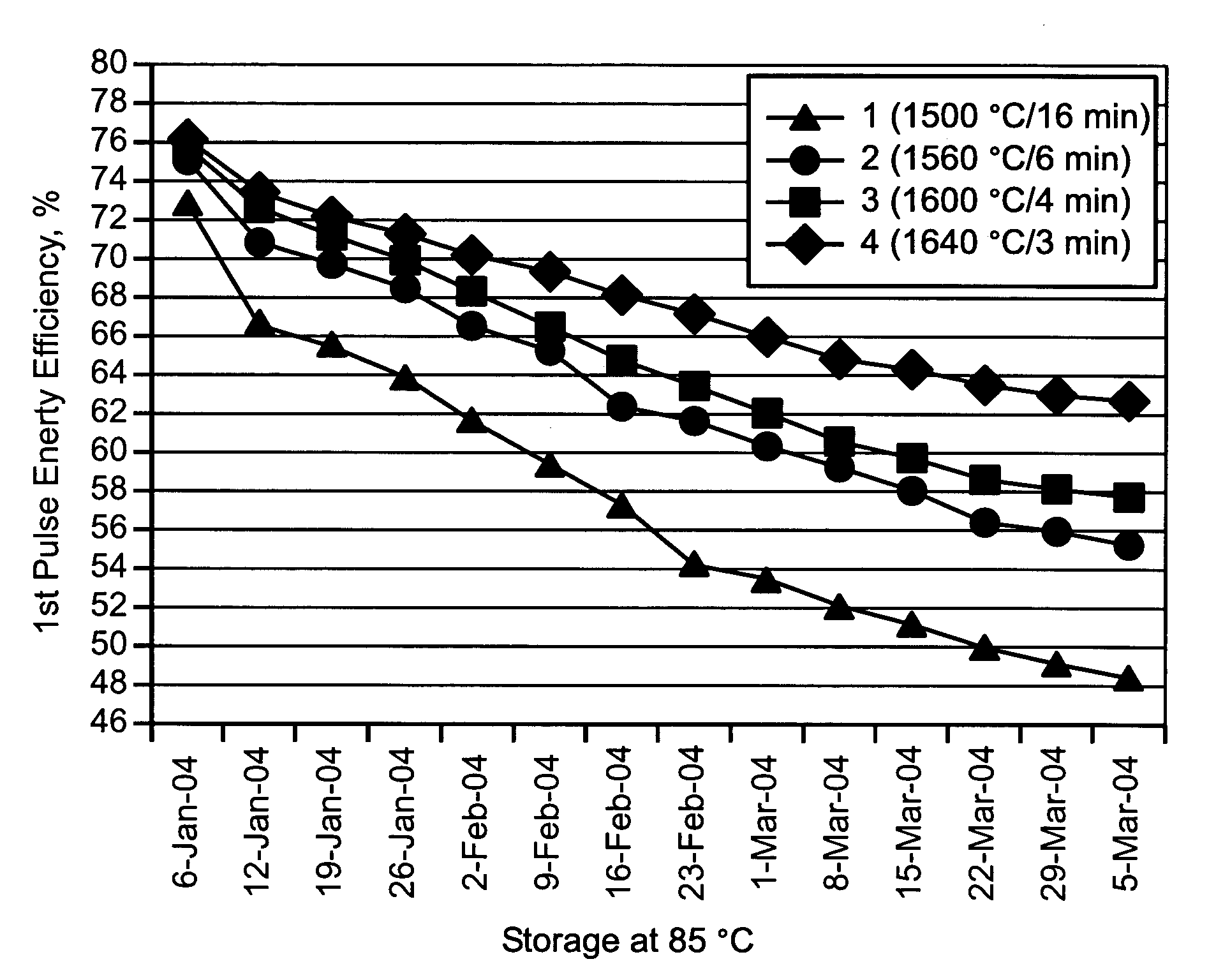Sintered valve metal powders for implantable capacitors
- Summary
- Abstract
- Description
- Claims
- Application Information
AI Technical Summary
Benefits of technology
Problems solved by technology
Method used
Image
Examples
example i
[0021]Five pressed powder tantalum pellets were sintered according to the varied conditions listed in Table 1. The pellets are designated as 1, 2, 3, 4 and 5 in the table. Pellet no. 1 was sintered at 1,500° C. for 16 minutes and served as the control. This is a relatively low temperature for a relatively long time. Pellets nos. 4 and 5 sintered at 1,640° C. for 3 and 4 minutes, respectively, had the lowest DC leakage (DCL) in units of nono-Amp / (microfarad×volt) (nA / CV), but they also had the lowest volumetric capacitance (AC capacity / cc) and energy density (J / cc). Pellet no. 3 sintered at 1,600° C. for 4 minutes exhibited lower DC leakage than the control pellet no. 1 while still maintaining a high volumetric capacitance and energy density.
[0022]
TABLE 1Run #SinteringACCap / ccnA / CVJ / cc1 1500 C. / 16 min294.21.279.3421560 C. / 6 min291.40.649.2231600 C. / 4 min294.90.549.3041640 C. / 3 min288.70.459.1551640 C. / 4 min288.10.449.02
[0023]FIG. 1 is a graph of the 1st charge / discharge pulse energy ...
example ii
[0024]Twelve pressed powder tantalum pellets were divide into two groups. Group I contained five pellets sintered at 1,500° C. for 16 minutes and served as a control. Group II contained seven pellets sintered at 1,600° C. for 3 minutes. This is listed in Table 2.
[0025]
TABLE 2SinteringCapacitanceDCLEnergy(° C. / min.)(μF / cc)(μA)(J / cc)Group I1500 / 1640046.59.238Group II1600 / 3 39738.99.17
[0026]FIG. 2 is a graph of the average 1st charge / discharge pulse energy efficiency (E %) at 37° C. versus storage time at 85° C. for the various pellets listed in Table 2. Again, the improvement in energy efficiency stability of the Group II pellets sintered according to the present invention is demonstrated.
[0027]Thus, an optimal sintering protocol for a given powder morphology and formation voltage is at a relatively higher temperature with a shorter sintering time than is used in conventional practice. This allows for improved long term performance stability while still maintaining a high volumetric ...
PUM
| Property | Measurement | Unit |
|---|---|---|
| Temperature | aaaaa | aaaaa |
| Temperature | aaaaa | aaaaa |
| Temperature | aaaaa | aaaaa |
Abstract
Description
Claims
Application Information
 Login to View More
Login to View More - R&D
- Intellectual Property
- Life Sciences
- Materials
- Tech Scout
- Unparalleled Data Quality
- Higher Quality Content
- 60% Fewer Hallucinations
Browse by: Latest US Patents, China's latest patents, Technical Efficacy Thesaurus, Application Domain, Technology Topic, Popular Technical Reports.
© 2025 PatSnap. All rights reserved.Legal|Privacy policy|Modern Slavery Act Transparency Statement|Sitemap|About US| Contact US: help@patsnap.com



